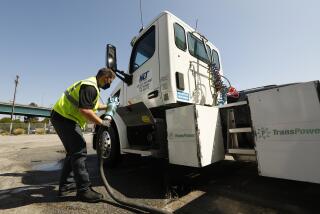Propane Could Make Converts Out of Pre-’94 Vehicle Owners
- Share via
If you want the best of gaseous fuels without the drawbacks of compressed natural gas, you might consider converting your vehicle to propane--that is, if you have an older vehicle.
Liquid petroleum gas, or LPG, offers all the advantages of CNG over gasoline (lower operating and maintenance costs and dramatically lower emissions) with a couple of distinct advantages over methane (namely, longer range and wider availability).
Ford Motor Co.’s F-150 bi-fuel pickup--one that can run on gasoline or propane--is virtually the only light-duty vehicle consumers can buy off the showroom floor if they want to motor in the propane lane.
General Motors Corp.’s Chevrolet and GMC truck lines also offer medium- and heavier-duty models in LPG, but they are aimed at the kinds of buyers who haul big trailers or run large cattle ranches.
Which leaves most drivers with the option of converting another vehicle.
But in California, propane conversion is practically impossible for 1994 and later-model vehicles because of its incompatibility with the high-technology emission systems required on gasoline-powered cars of recent vintage.
For 1993 and earlier vehicles, conversion to propane can cost anywhere from $2,000 to $5,000, said Steve Moore, vice president of business development for Mutual Liquid Gas & Equipment Co. in Gardena. The payoff comes in fuel costs that are generally 25% to 40% less than gasoline, he said.
LPG is used in the form of a liquid under pressure; a tankful contains 270 times the energy of a tank with the same volume of compressed natural gas. In practical terms, Moore said, that means he can easily drive his propane-fueled 1993 Ford Crown Victoria to Las Vegas and back on one tankful.
Even so, refueling is no problem virtually anywhere in the country, since propane is in demand both as a motor fuel for heavy-duty commercial vehicles and as a fuel for barbecues, for forklifts and in many recreational vehicle generators.
*
But propane’s fatal flaw has been a lag in fuel system technology that came to light when the state’s Low-Emission Vehicle Program began in 1994, said John Swanton, an air-pollution specialist with the California Air Resources Board.
“We did a lot of testing and found out that the alternative-fuel vehicle aftermarket kits were not performing as well as the original equipment manufacturers’ kits,” Swanton said.
Technicians in state testing labs, he said, found that under the high-tech 1994 standards, emission systems in propane-fueled vehicles lost efficiency after a few thousand miles, causing them to emit more pollutants than identical cars and trucks running on gasoline.
“In the 1970s, the [alternative] fuel was clean enough that you just put it on a dirty car and it would automatically clean it up,” Swanton said. “But new cars are so much cleaner that if you put a less sophisticated system on, even if you’re starting with a cleaner fuel, you’re getting higher emissions in the long run.”
Moore said the LPG industry has begun a modest initiative that may in the future expand to new-car showrooms. But for now, if you want the advantages of LPG, you’ll have to settle either for that Ford truck or converting a vehicle of pre-1994 vintage.
More to Read
Inside the business of entertainment
The Wide Shot brings you news, analysis and insights on everything from streaming wars to production — and what it all means for the future.
You may occasionally receive promotional content from the Los Angeles Times.










